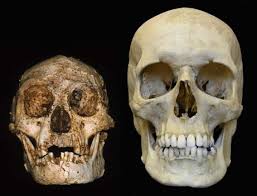 Her scientific name is Homo floresiensis, her nickname is "the hobbit," and the hunt is on to prove that she and the dozen other hobbits since discovered are not a quirk of nature but members of a distinct hominid species.
Her scientific name is Homo floresiensis, her nickname is "the hobbit," and the hunt is on to prove that she and the dozen other hobbits since discovered are not a quirk of nature but members of a distinct hominid species.
The discovery of Homo floresiensis shocked and divided scientists. Here apparently was a band of distant relatives that exhibited features not seen for millions of years but were living at the same time as much more modern humans. Almost overnight, the find threatened to change our understanding of human evolution.
It would mean contemplating the possibility that not all the answers to human evolution lie in Africa, and that our development was more complex than previously thought.

 Science Glance
Science Glance Critics of the teaching of evolution in the nation’s classrooms are gaining ground in some states by linking the issue to global warming, arguing that dissenting views on both scientific subjects should be taught in public schools.
Critics of the teaching of evolution in the nation’s classrooms are gaining ground in some states by linking the issue to global warming, arguing that dissenting views on both scientific subjects should be taught in public schools. Just 50 miles off the Pacific Northwest coast is an earthquake hotspot that threatens to unleash on Seattle, Portland and Vancouver the kind of damage that has shattered Chile.
Just 50 miles off the Pacific Northwest coast is an earthquake hotspot that threatens to unleash on Seattle, Portland and Vancouver the kind of damage that has shattered Chile. The earthquake that killed more than 700 people in Chile on Feb. 27 probably shifted the Earth’s axis and shortened the day, a National Aeronautics and Space Administration scientist said.
The earthquake that killed more than 700 people in Chile on Feb. 27 probably shifted the Earth’s axis and shortened the day, a National Aeronautics and Space Administration scientist said. Dwarf galaxies gobbled up by our own Milky Way make up about a quarter of the 160 star-packed "globular clusters" littering the galaxy, astronomers report Tuesday.
Dwarf galaxies gobbled up by our own Milky Way make up about a quarter of the 160 star-packed "globular clusters" littering the galaxy, astronomers report Tuesday. Scientists say they have confirmed that a meteorite that crashed into earth 40 years ago contains millions of different organic compounds. It is thought the Murchison meteorite could be even older than the Sun.
Scientists say they have confirmed that a meteorite that crashed into earth 40 years ago contains millions of different organic compounds. It is thought the Murchison meteorite could be even older than the Sun. Planet-hunters have discovered two "super-Earths" orbiting two nearby Sun-like stars. These rocky planets are larger than the Earth but much smaller than ice giants such as Uranus and Neptune.
Planet-hunters have discovered two "super-Earths" orbiting two nearby Sun-like stars. These rocky planets are larger than the Earth but much smaller than ice giants such as Uranus and Neptune.






























